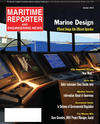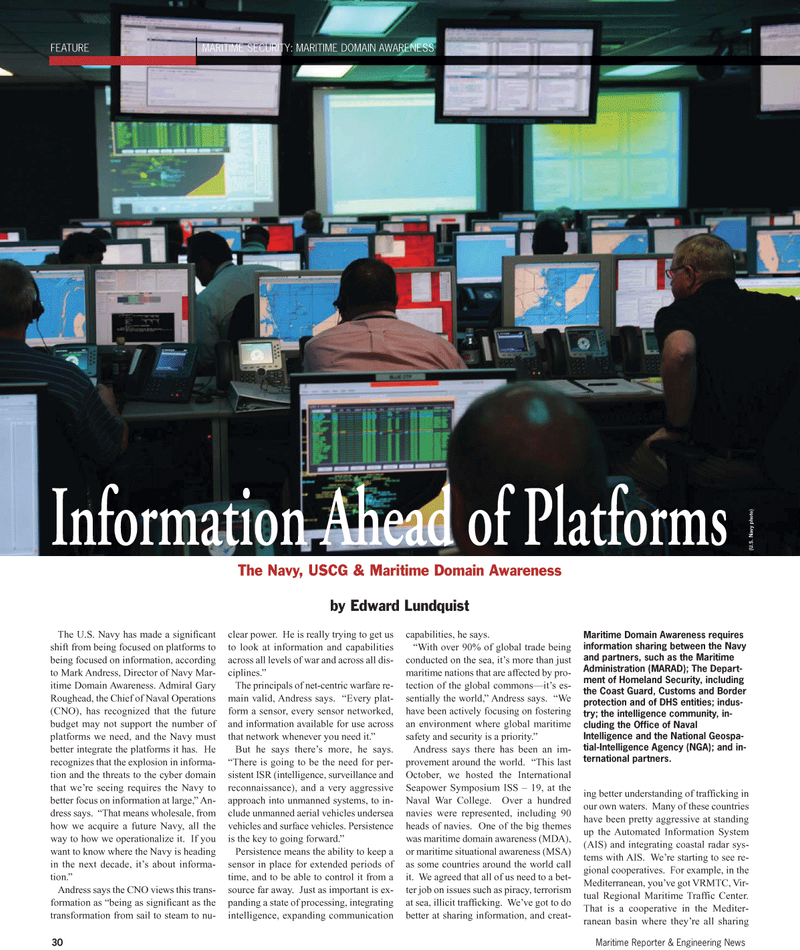
Page 30: of Maritime Reporter Magazine (February 2, 2010)
Read this page in Pdf, Flash or Html5 edition of February 2, 2010 Maritime Reporter Magazine
30 Maritime Reporter & Engineering News
FEATURE MARITIME SECURITY: MARITIME DOMAIN AWARENESS
The U.S. Navy has made a significant shift from being focused on platforms to being focused on information, according to Mark Andress, Director of Navy Mar- itime Domain Awareness. Admiral Gary
Roughead, the Chief of Naval Operations (CNO), has recognized that the future budget may not support the number of platforms we need, and the Navy must better integrate the platforms it has. He recognizes that the explosion in informa- tion and the threats to the cyber domain that we’re seeing requires the Navy to better focus on information at large,” An- dress says. “That means wholesale, from how we acquire a future Navy, all the way to how we operationalize it. If you want to know where the Navy is heading in the next decade, it’s about informa- tion.”
Andress says the CNO views this trans- formation as “being as significant as the transformation from sail to steam to nu- clear power. He is really trying to get us to look at information and capabilities across all levels of war and across all dis- ciplines.”
The principals of net-centric warfare re- main valid, Andress says. “Every plat- form a sensor, every sensor networked, and information available for use across that network whenever you need it.”
But he says there’s more, he says. “There is going to be the need for per- sistent ISR (intelligence, surveillance and reconnaissance), and a very aggressive approach into unmanned systems, to in- clude unmanned aerial vehicles undersea vehicles and surface vehicles. Persistence is the key to going forward.”
Persistence means the ability to keep a sensor in place for extended periods of time, and to be able to control it from a source far away. Just as important is ex- panding a state of processing, integrating intelligence, expanding communication capabilities, he says. “With over 90% of global trade being conducted on the sea, it’s more than just maritime nations that are affected by pro- tection of the global commons—it’s es- sentially the world,” Andress says. “We have been actively focusing on fostering an environment where global maritime safety and security is a priority.”
Andress says there has been an im- provement around the world. “This last
October, we hosted the International
Seapower Symposium ISS – 19, at the
Naval War College. Over a hundred navies were represented, including 90 heads of navies. One of the big themes was maritime domain awareness (MDA), or maritime situational awareness (MSA) as some countries around the world call it. We agreed that all of us need to a bet- ter job on issues such as piracy, terrorism at sea, illicit trafficking. We’ve got to do better at sharing information, and creat- ing better understanding of trafficking in our own waters. Many of these countries have been pretty aggressive at standing up the Automated Information System (AIS) and integrating coastal radar sys- tems with AIS. We’re starting to see re- gional cooperatives. For example, in the
Mediterranean, you’ve got VRMTC, Vir- tual Regional Maritime Traffic Center.
That is a cooperative in the Mediter- ranean basin where they’re all sharing
Information Ahead of Platforms
The Navy, USCG & Maritime Domain Awareness by Edward Lundquist
Maritime Domain Awareness requires information sharing between the Navy and partners, such as the Maritime
Administration (MARAD); The Depart- ment of Homeland Security, including the Coast Guard, Customs and Border protection and of DHS entities; indus- try; the intelligence community, in- cluding the Office of Naval
Intelligence and the National Geospa- tial-Intelligence Agency (NGA); and in- ternational partners. (U.S. Navy photo)

 29
29

 31
31
